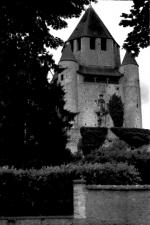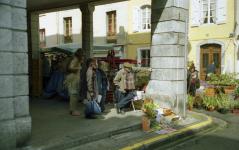|
Krasnogorsk Zorki 4 |
Manufactured or assembled in Former USSR from 1956 to 1973.
Index of rarity in France: Infrequent (among non-specialized garage sales)
Inventory number: 866
See the complete technical specifications
Chronology of cameras Krasnogorsk
Traduction de Sylvain Halgand.
Zorki 4 was manufactured 1956 to 1973. This one goes back precisely to 1971, because its job number to 8 digits starts with 71.
This 35 mm was very produced and is thus easy to find. Like considerable Russian cameras, there exists either with an inscription into Cyrillic, or an inscription in Roman characters.
The rangefinder is coupled, the viewfinding is not very comfortable and the handling of the selector speed is not easy for my roved fingers!
USE OF THE ZORKI 4
(This document contains notes on cameras MIR & ZORKI 5 AND 6 of close design)
by Thierry the GUENNEC Mai 2002 based on the Soviet original document and research of Mark THARPE
A little history, Camarades!
The ZORKI 4 constitutes one of the last evolutions of the Soviet clone of the LEICA II and III. As of the pre-war period, the USSR carried out copies quasi-in conformity of the legendary Germanic camera… For completely frank being, the tolerances of production and the choice of materials not being subjected in Soviet Union to the drastic criteria of LEITZ factories , the copies carried out in Kharkov or elsewhere had alas, neither the quality of completion, nor the consistency characteristics of their prestigious models.
However these cameras are not deprived of qualities… the shutter release requires indeed the softness of touching of a kolkhoz tractor operator, the orders are hard and the not very readable inscriptions, but these mechanical bodies are in general robust and easy to repair . Equipped with a mounting in screwing 39 mm (that of the LEICA of pre-war period and many other telemetric marks prestigious such CANON), they can be equipped with multiple optics: Leitz, Canon, Minolta etc and accept even very recent (and expensive) Japanese productions with the optical formulas the last cry (RICOH or Voigtländer). If you must be satisfied with optics of origin “made in CCCP”, will know that they are, for the majority of them, of servile copies of lenses CONTAX or LEITZ of the Forties and, for this reason, good or excellent. The optical range of origin of marks ORION, JUPITER, RUSSAR or adaptable MIR on your ZORKI is complete since it includes a 20 mm, one 28 mm, one 35 mm, several 50 mm more or less luminous , one stunning 85 mm and one very correct 135 mm but not very easy to use on this body!
Since the collapse of the Soviet block, the very important production of these cameras makes them at the same time relatively accessible and currents even if their value has been rather directed with the rise because of the collectors for a few years (between 20 and 60 euros). Optics, a little rarer, is also negotiated between 45 and 75 Euros each one. Only some accessories such the auxiliary finders can be rare and thus expensive…
The ZORKI 4 presents a gap of size however: it does not have any type of measurement of the light and no automatism… Its user will have to measure the light thanks to a hand cell or with its experiment to choose aperture and speed!
The ZORKI 4 exists in two versions, 4 or 4 K, this last being equipped with an unpleasant (but practical) winding lever made of buckled plate whereas the precedent is armed using a button. You wish to know the year of your ZORKI? The first two figures of the n° of series (on the back of the camera) are those of the year of manufacture to the XX° century. It will be the same besides for any optics or accessory coming from the ex-USSR or of Russia or the Ukraine current…
For memory, to the ZORKI 4, succeeded the MIR, basic version of the precedent deprived slow speeds with an indication maximum speed to the 1/500 of secondes., (the 1/1 000 of secondes exist but is not engraved on the barrel speeds! Would it be about a typically Soviet form of humor?), then the ZORKI 5 & 6 which differed mainly from model 4 by their large base rangefinder , a back assembled on hinge, of the catches of flash “M” and “X” separated, a large button of rewinding easy to handle (finally!) but were unfortunately limited as for the speed range (of the 1/30 to the 1/500 of secondes only).
For a photographic practice with the service of Parti and Peuple!
How to charge this jewel of Soviet socialist industry?
Except for models 5 & 6, the Fed Zorki and other Mir take care in “dismounting” the back… For that, it is enough to raise the two half hitches located under the sole of the body, to make them swivel of 180° towards the interior, the back can then slide on its slides.
To charge the ZORKI, we place a 35 mm cartridge on the left in housing and we engage well the perforations on the notched reel located on the right . One of the characteristics of the Russian material is that the starter of film will pass UNDER the receiving reel. To advance film to make sure that the flange (2) (it is used to disconnect the winding to rewind film) located under the shutter release (3) is well positioned (red reference marks aligned towards the back of the camera). To hang the starter then, to advance film thanks to the lever or button (1) and to start to two or three times.
1. Retardator
2. Retarder declenchor of the
3. Flash PC
4. Winding (here by button)
5. Exposures counter
6. Rewinding ring
7. Shutter release
8. Speed selector
9. Rangefinder window
10. Accessory clip (not synchro for the flashes!)
11. Finder
12. Rewinding Button
13. Dioptric finder setting
1) Winding and view counter
The ZORKI is armed thanks to the button (4) which carries out an approximately anti-clockwise rotation of 3/4 of turn or with the lever which has a race of 180° to advance film with the following view and to arm the shutter. The device of winding carries, above, the meter of sights which does not return automatically to zero at the time of the aperture of the back: this must be done by the user…
2) Speed selection
The speeds selector (8) is on the left shutter release surrounded by a fixed ring carrying various speeds. As the selector turns during the obturation and of the advance of film, we should not block its rotation in these two cases. It is also the reason for which we should NEVER select a speed BEFORE to arm the ZORKI !
After having armed the body, to gently draw the selector to the top placing the reference mark (milked red or black) vis-a-vis speed chosen, to slacken the selector which takes again its place then… Never not to force rotation between 1 secondes. and 1/30 in the anti-clockwise direction, the selector does not turn, indeed, on 360° and that would be likely to damage the mechanism!
3) Rangefinder
The ZORKI offers, for a few kopecks, a viewfinding based on the same principle as a LEICA M6 or a HEXAR RF, professional bodies being worth several thousands of Euros…
To be completely honest, it is much noisier and rustic that the epigones of the modern or old LEICA… However, this modest Soviet camera is alone to propose, to my knowledge, a setting with the user view via the lever (13) placed under the button of rewinding. The majority of the carriers of glasses can thus aim without them! The rangefinder where necessary can “be readjusted” without demounting of the higher cap: it is enough to deposit the screw located close to the left lower angle of the window of the finder and to operate the adjustable tangent placed inside this aperture. In the center of the finder is a yellow brilliant zone: it is the beach of Focusing of the rangefinder, as long as the Focusing is not correct one sees a duplicated image there. When stock is taken, the two images on the contrary are superimposed perfectly (finally “perfectly”… according to the Soviet criteria). This finder corresponds to the field of viewfinding of a standard lens of a focal distance of 50 mm (or 5 cm for the Soviet optics oldest), all the other lenses require the use of an additional finder placed in the clip on the top of the body… the finder of the always being useful ZORKI, in this case, with the Focusing and the additional finder with framing. This additional finder can be multi-focal distances or to correspond only to one focal distance, it is in any event essential as soon as another optics is used that the 50 mm…
4) Use a flash
Caution! the clip of this body does not comprise any contact, a flash will not function while being gone up above! It could be even damaged ! It is thus necessary to connect thanks to a cord the flash for catch PC (3) and to fix the flash on a bar carry-flash which one will screw in the nut of foot under the body. IT is then necessary to place the selector speeds on the 1/30 of secondes. and to take care that the selector “M/X” is on “X” (around the ring speeds), to refer to the instructions of the flash to choose the aperture of the lens according to the sensitivity of film. Certain rare ZORKI are equipped with a regulator of synchro flash: they carry in addition to M and X indications 0,5,10,15,20,25 for these models to place the selector on 0 to use an electronic flash.
5) Retarder
This camera has also a retarder (1) on the frontage: to arm the camera, to turn the retarder in the anti-clockwise direction until it points downwards, to start with the button (2) placed above.
6) To change lens
Optics with mounting LTM is screwed and unscrewed, with the assembly to tighten them well until their arrival into obstinate but without exaggeration… Certaines Russian optics have the same screw pitch but are intended for reflex camera ZENITH, it is impossible to make the Focusing with bus it do not have a mobile “crown” behind of the lens. It is indeed this device which fascinating support on the roller of the rangefinder inside the body actuates this help with the Focusing. Optics for reflex camera, moreover, does not have same pulling: it would be thus impossible to take stock while trusting the indications related to their ring of Focusing…
7) Rewinding
Once the finished film (“towards” the 36ème seen…), the winding becomes… impossible! To then turn the flange of rewinding towards the left (6) and to draw the button (12) upwards. To then turn until the unhooking of the starter (that feels and… gets along) to open the back and to recover exposed film!
Epilog
This ZORKI 4K n° 77947719 always functions after this heavy surgical operation and 20 years of good and faithful services !

Interesting links or bibliography :
| Sur Camera-wiki.org, suggested by Sylvain Halgand |
| Sur mes-appareils-photos.fr, suggested by Eric Carlhan |
Add a link or element of bibliography, a picture taken with this camera, a picture of box or an ads about this camera
Your photos taken with the same camera:

| 
| 
| 
| 
| 
|
Cameras from Ebay France (Krasnogorsk) (Uploaded each 3 hours)
 zenit e appareil photo soviet era 19,00 euros Finira le 04-05-2024 à 18:58:38 |








